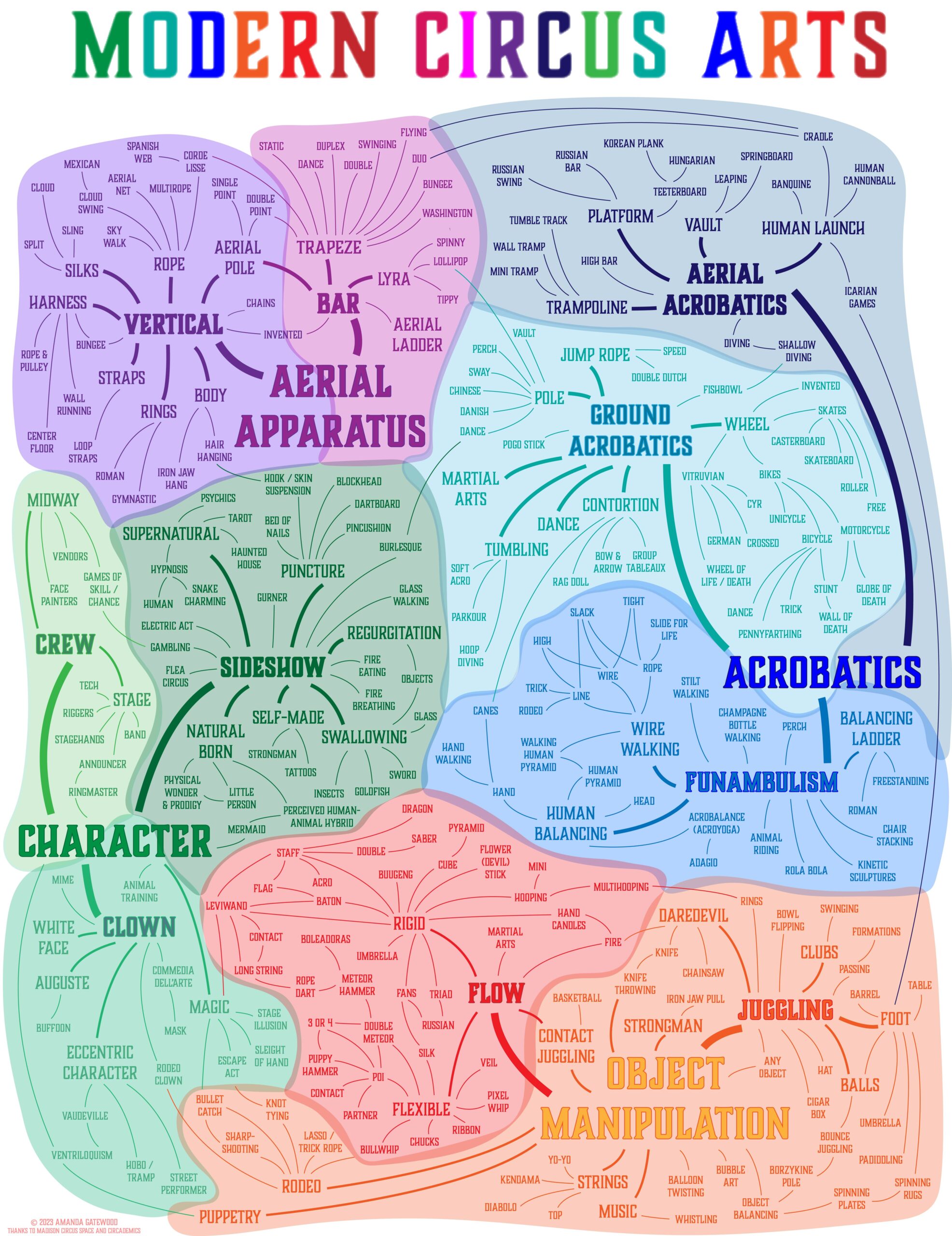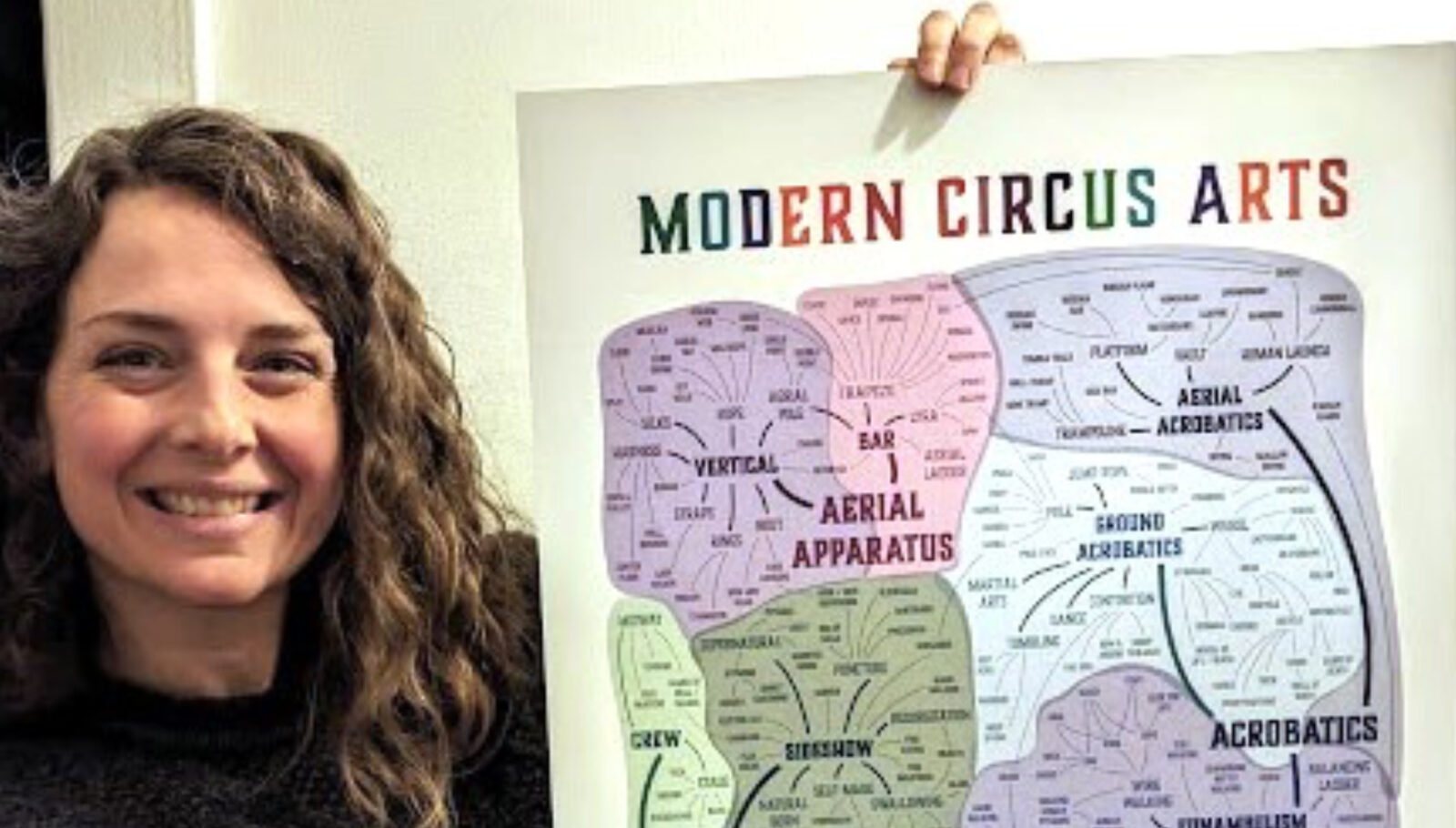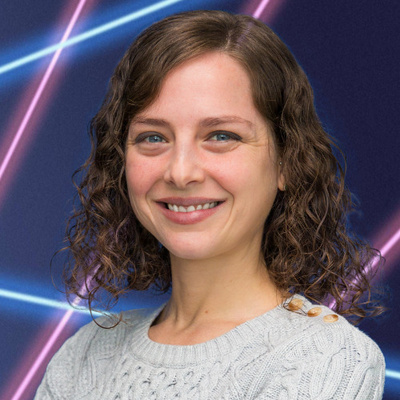Developing a Circus Organizational System
I recently developed a visual that shows the ways that over 300 circus disciplines, skills, and apparatuses are connected to one another. Along the way, I got to connect with dozens of circus artists and researchers around the world. I would like to share some of this journey and what I learned with the circus community.
I’ve included in this article a bit about how and why I began this project, and how I updated an already existing system. I extend gratitude to so many circus artists and researchers who helped me along the way. Lastly, I talk about some of the impacts of the project, and share how you can get your own copy of this limited edition print.

How the Modern Circus Arts project began
I’m a recreational circus artist and coach focusing on German wheel and clowning. Unfortunately, I wasn’t able to access gymnastics or dance training when I was a child in Kentucky, USA. In fact, I was in my 30s before I started training circus at all. Now I am 40 years old, and so it takes me longer to learn circus skills than it does for a younger, formally trained person. Luckily, I’m part of the Madison Circus Space where I can see a diversity of circus arts being practiced, and learn from lots of different professional and recreational artists.
In 2019, I wanted to expand some of my circus skill set, but I wasn’t sure what might be a good fit for me. I wondered if there were any circus skills that were similar to those that I already had developed. As I researched, I found dozens of circus skills and apparatus that I was unaware of, including somewhat obscure apparatus asskywalkand Jonathan Morin’scrossed wheel.
As I researched, I found a blurry image of the Gurevich System, which organized circus disciplines. The Gurevich System was developed in the 1950s and 1960s in the Soviet Union by Zinovy B. Gurevich. This image was created to visually organize the curriculum taught at the prestigious Moscow Circus School and the acts that were common in the Soviet Union at the time.

I learned a lot from the Gurevich System. For example:
- The Gurevich System placesrolling globe androla bola close to one another. This implied that these apparatus use similar skills.
- I assumed that the image included many (or maybe even most) of the popular circus acts performed in the Soviet Union in the 1960s and 1970s. I thought this might be interesting historical information, though I could not verify it.
- The Gurevich System has large sections devoted to horsemanship and animal training. This interested me because I have rarely seen animals perform in the circus shows that I have attended. That made me think about the impact of the animal rights movement on modern circus.
I loved the Gurevich System for how it expanded my mind! But I couldn’t help but notice that some popular acts were entirely missing (for example, aerial silks or Cyr wheel) because they had not yet been popularized. I also conceptualized some of the skills differently than the Gurevich System, or I wasn’t sure what some of the entries meant. (For example, is ahorizontal bar the same as what I refer to as a Russian bar, a balance beam, or a gymnastic high bar? Why ishigh wire placed in a different category thantight wire?)
So I set out to update the Gurevich System and bring it into the 2020s.
How I updated the Gurevich System
At first, I thought I would research and create the graphic only for myself. I got out a big piece of paper and started drawing by hand, adding acts that I had seen in person or online. I watched hundreds of circus videos on YouTube, reviewed websites of circus prop vendors such as Flowtoys and Renegade Juggling, and read books about circus history and research.
I eventually began to move some of the Gurevich System categories around. In my graphic, for example,magichas been moved betweencharacterandobject manipulation, which is also wherepuppetry(a new addition) was placed. I addedwheelsand aerialsilks. I also included the flow arts in my system and added many popular (and rare) juggling props. I added about 200 skills and disciplines to the original Gurevich System.
Next, I placed a draft of my graphic and a pen on a table in a public area of the Madison Circus Space, where I am a member and coach. I invited other members to annotate the page in an open-source fashion. The biggest area of additions and corrections was in the area of the flow arts, where our juggling community had some overlap.
Then, I digitized the graphic and shared it online in theCircademics Facebook group. Circademics is a large, international, online group of academic, professional, and recreational circus artists, researchers, and thinkers dedicated to research and discussion “pertaining to the theory, research, and practice of developmental circus arts.” The group has over 3,800 members who request and share historical and academic circus resources, share book recommendations and publications, and discuss topics related to circus.
I shared different drafts with Circademics three times over three years before deciding it was ready to publish. I incorporated hundreds of comments from circus artists, professional and armchair circus researchers, librarians, circus school directors, prominent circus dynasty family members, publishers, graphic designers, and others.
The Circademic community was amazing. They introduced me toDokucirco and their beautifully designed system. Dr. Marco Bortoleto reached out to me directly to share a publication that chronicled his own research and system, developed in Brazil and published in 2017 (seeBortoleto, Marco CA.Educacao Fisica Escolar e Praxiologia Motriz: compreendendo as practicas corporais. Editora CRV Ltda, (2017), pp. 55-79.). Szandra Szonday, a museologist from the Library and Archives of Hungarian Circus Arts, shared a link to a system from German researcher Rolf Lehmann from the 1970s. Circus artists also commented to help me reconfigure whole sections (especially the flow and aerial sections).
I was surprised that I wasn’t able to easily find information about these other systems, especially since circuses and their performers cross the national and linguistic borders that seemed to be keeping these systems apart! Through Circademics, I met Dr. LaReina Hingson, and together we wrote an academic article about the different systems. This article is available by request, and has been submitted for publication – so hopefully it will be available soon. In the meantime, some circus organizational systems that Dr. Hingson and I compiled are available online for review:
- Gurevich system (Soviet Union, developed 1950s,page 67 here)
- the Hovey Burgess system (U.S.A., developed 1974,page 69 here)
- the Dokucirco system (Mexico, developed 2016,bottom of page)
- the Gatewood system (U.S.A., developed 2023,available as poster here)
The impact of the Modern Circus Arts project
I was incredibly impacted by creating the Modern Circus Arts organizational system. For one, I was able to connect with lots of kind, thoughtful, intelligent, fascinating people who are involved in circus in one way or another.
Secondly, the project did help me expand my personal circus practice. In the time since I started making this system, I have started training Cyr wheel, which I have been able to learn a bit more quickly than I otherwise would due to my experience with German wheel. I recognize that I am growing older, too, and so I started looking for less dangerous activities that I will hopefully be able to continue into my older age. I had been previously unaware of leviwand and rope dart, but these captivated my interest and I have started practicing them. I am also working on becoming a more committed and thoughtful clown, with a better understanding of the history and styles of clowning.
I’m less sure of the impact for YOU, the reader, or for the circus world more generally. On one hand, who cares if a researcher tries to organize the circus arts? Writing circus words on a page does not limit nor does it expand the capacity for humans to create and perform circus.
On the other hand, I believe that we can learn several things from circus organizational systems. Dr. Hingson and I identified a few ways that circus organizational systems can benefit the circus arts. They can:
- Comprehensively organize the skills, disciplines, and apparatus that the system’s creator believed were important to create “circus.”
- Serve as a cultural record of how acts are performed in relation to one another.
- Show the bounds of human creativity at a particular moment in history.
- Suggest a common language for circus skills and apparatus.
- Teach what steps an artist should take in order to learn a new skill.
- Help a teacher or school set their curriculum.
There is more than one way
I am honored to be included in the list of people who have tried to make a circus organizational system. To quote George Box, “All systems are wrong, but some are useful.” Is one system more “right” than the others? I don’t think so. Each system is useful in its own right, and teaches us something different about the circus arts, and where and how they are practiced.
It’s my goal that the Modern Circus Arts poster inspires insights, discussion, and debate in the circus community. Circus artist Ripley Burns told me that when she saw the graphic, “I was excited to see puppetry in between ‘character’ and ‘object-manipulation’. Like a light bulb going off. I had never thought about it exactly in that way and it was satisfying to see it explained so simply.” This is exactly how I felt making the graphic.

I don’t think my system is perfect, and in fact I think it’s sometimes wrong. Some provocative criticism that I have heard as the result of my graphic are:
- There has been a robust conversation about what the “parent” categories in circus should be. Historically, these have changed over time as circus culture and schools changed. Many schools have their own core disciplines, which are likely to be different than what I chose.
- Many people have asked me why I included the title “Modern Circus Arts.” What are the “modern” circus arts? How are they different than classical, traditional, contemporary, or new/nouveau circus arts? What time periods are included under the umbrella “modern”? (I’m an armchair circus researcher, so I didn’t work with a strict or specific criteria. My system might be thought of as “anything you might see in a circus circa 2020s.”)
- There have been interesting conversations about what skills belong where. For example, I included an “Aerial Apparatus” section, defined loosely as using apparatus that hang from above. There is separately an “Aerial Acrobatics” section, in which people are launched into the air from the ground. Who conceives of these differently, and why?
- Should there be a review of circus school curriculum to see what is most commonly taught, why, and how? Or a graphic created to describe how the apparatus were created over time?
- I was told at one point that the clowning and character section should not be included in ‘circus,’ because these are skills used topresentthe circus arts.
- I was also told that Flow Arts should not be included, because they are intended to be practiced at fire parties and therefore don’t count as a performance.
- Some sections that should be connected, but are not – for example Strongman Juggling (under “Object Manipulation”) and Strongman (under “Sideshow”). This was a limit of space in my graphic, but maybe someone else could show how more circus arts are connected to one another.
- In my opinion my graphic is Western- and U.S.-centric. (This is my own reflection; not a criticism yet leveled at me from others.) For example, I have a small section for miscellaneous Rodeo skills, presumably because of the popularity of “Wild West” acts in the United States, where I am from. But I scattered Asian-origin martial arts, magic, juggling, and musical skills throughout the graphic. Does this inflate the importance of rodeo skills and diminish the contributions of Asian circus artists? It may do so, though it was not my intention.
Just as I updated the Gurevich System, it would be a great honor if someday in the future someone decides that my system is important enough to substantially update. Circus is ever-evolving, so updates will always be needed!
Click here for more information about the Gatewood Modern Circus Arts graphic, and here to purchase a poster. Posters are in limited supply, so please order soon to ensure you receive a copy. A percentage of the proceeds will go to the Madison Circus Space, a non-profit circus arts facility in Wisconsin, USA. Contact Amanda at [email protected] if you would like to coordinate a copy of the poster for your local social circus organization. She can send a free poster for the cost of shipping. All photos and illustrations are courtesy of the author....
Do you have a story to share? Submit your news story, article or press release.





